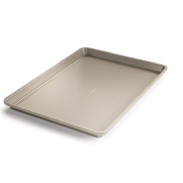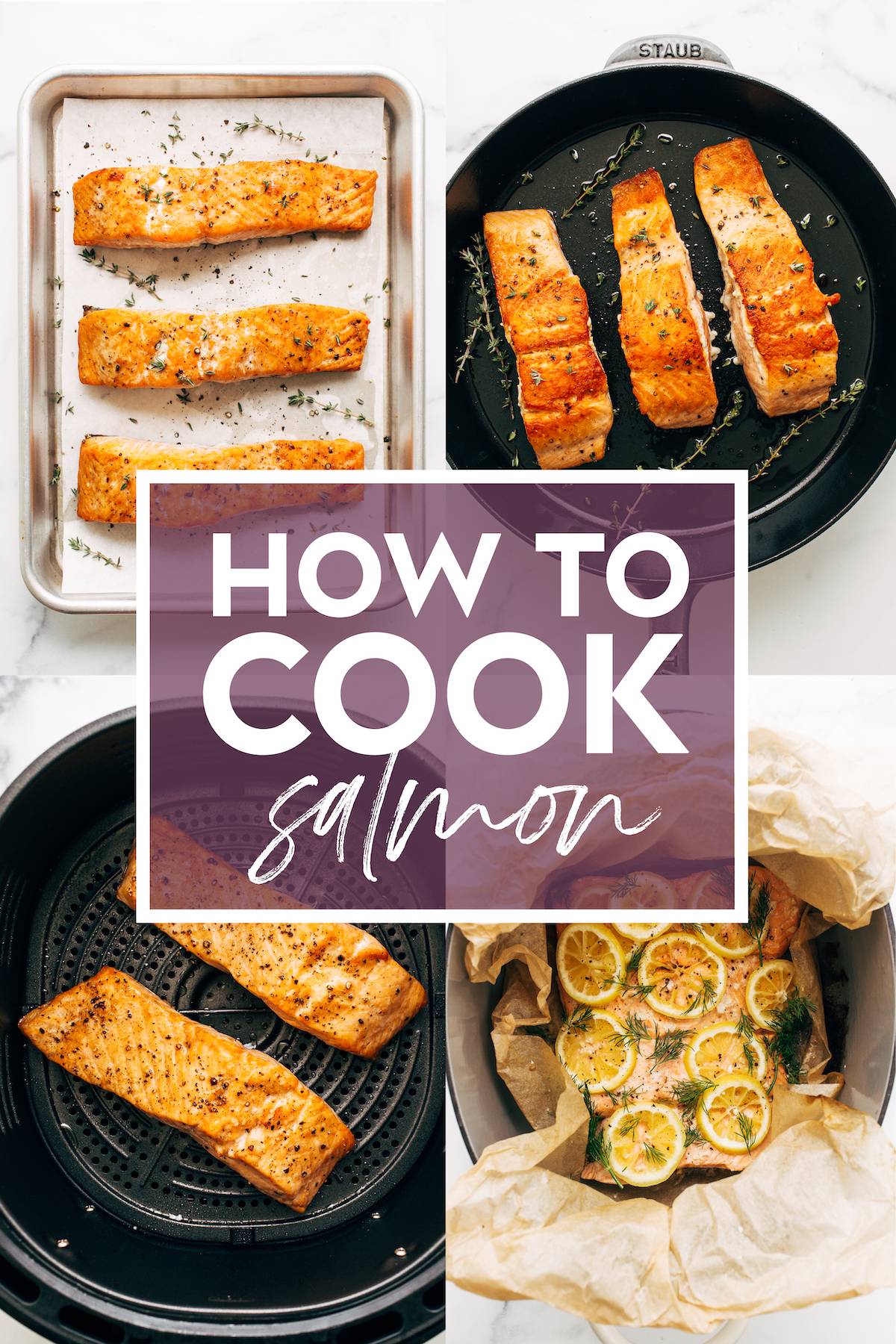
This post contains referral links for products we love for how to cook salmon. Pinch of Yum earns a small commission on these links at no cost to you, and the links will always be marked with an asterisk. We ♡ honesty!
Salmon! Perfect for a quick protein option atop a salad, mashed up and formed into burgers, or simmering in a beautifully rich curry sauce. Just truly so many ways to cook salmon and so many ways to prepare it.
So salmon lovers, salmon skeptics, gather around. We’re here to share all of our favorite ways to cook up that orangey-pink beauty.
In This Post: Everything You Need For How To Cook Salmon
Salmon Cooking Methods
- How to Bake Salmon
- How to Steam Salmon
- How to Air-Fry Salmon
- How to Sauté Salmon
- BONUS: How to Make Salmon Burgers
More on Buying and Cooking Salmon
- Tips on Buying Salmon
- Salmon Doneness
- Eating Raw Salmon
- How to Remove the Skin on Salmon
- Nutritional Benefits of Salmon
- Our Favorite Salmon Recipes
- Products to Make Cooking Salmon a Breeze
Prefer To Watch Instead Of Read?
How To Bake Salmon
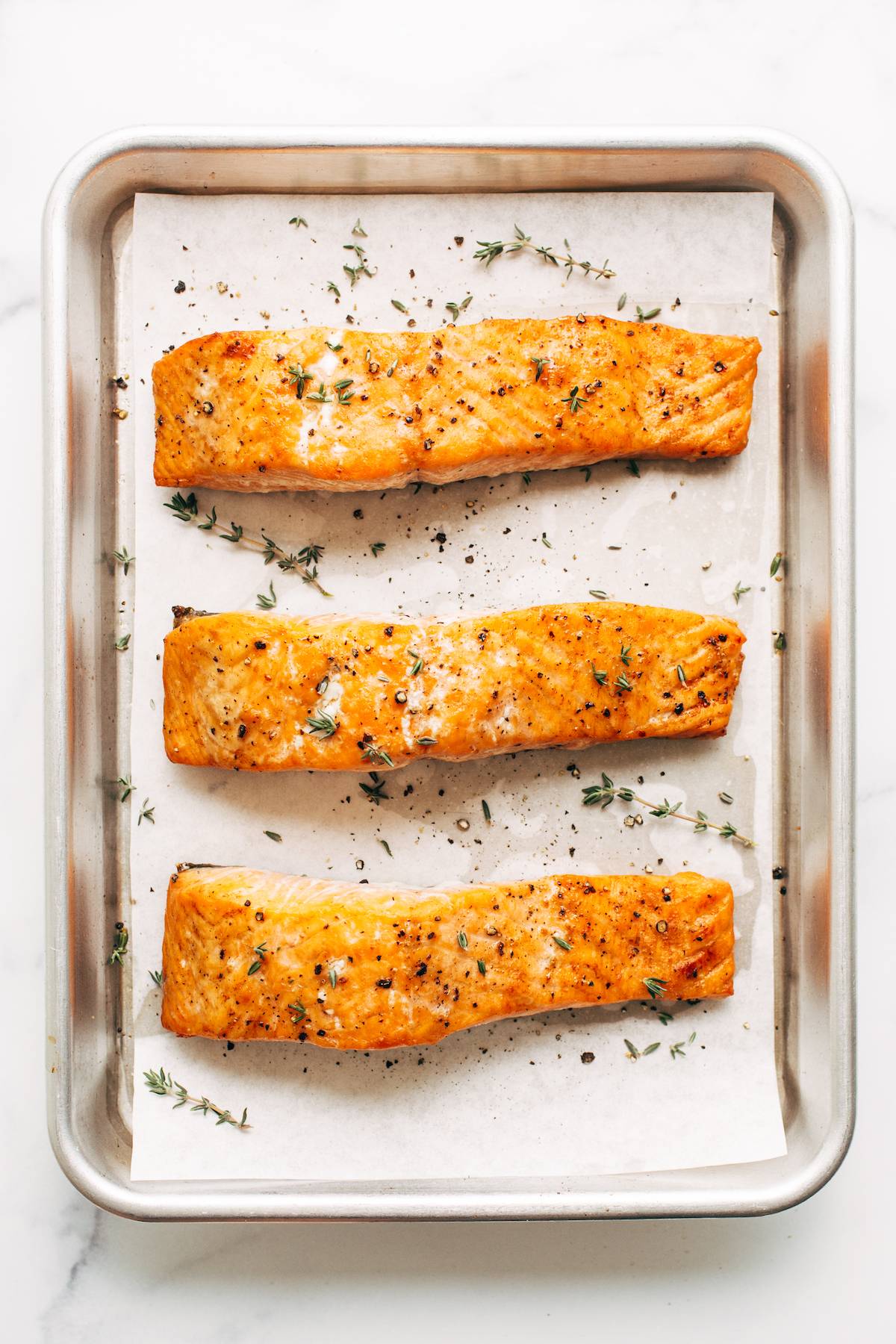
When to Bake Salmon
For if you want a fairly hands-off and consistent result, or want to combine it on a sheet pan with other ingredients to make it a one-pan meal. If you like a crispy top layer (who doesn’t?), you can also crank up the broiler at the end. This is our go-to method!
Directions
- Preheat your oven to 425 degrees F. Add a drizzle of olive oil to your salmon and season the fillets to your liking.
- Place salmon on a parchment paper-lined or foil-lined baking sheet. If you’re lining your baking sheet with foil, just give it a quick spray with non-stick cooking spray. Bake salmon fillet for 5-6 minutes, depending on fillet thickness. For salmon that’s 1″+ thick, bake for 8 minutes.
- When salmon easily flakes off with a fork, is around 125 to 130 degrees F, and the flesh looks opaque and not “raw”, the fish is done!
Watch How to Bake Salmon
Recipes Using Baked Salmon
- Hot Honey Salmon
- Baked Salmon with Amazing Lemon Sauce
- Coconut Curry Salmon
- BBQ Salmon Bowls with Mango Avocado Salsa
How To Steam Salmon (In Parchment)
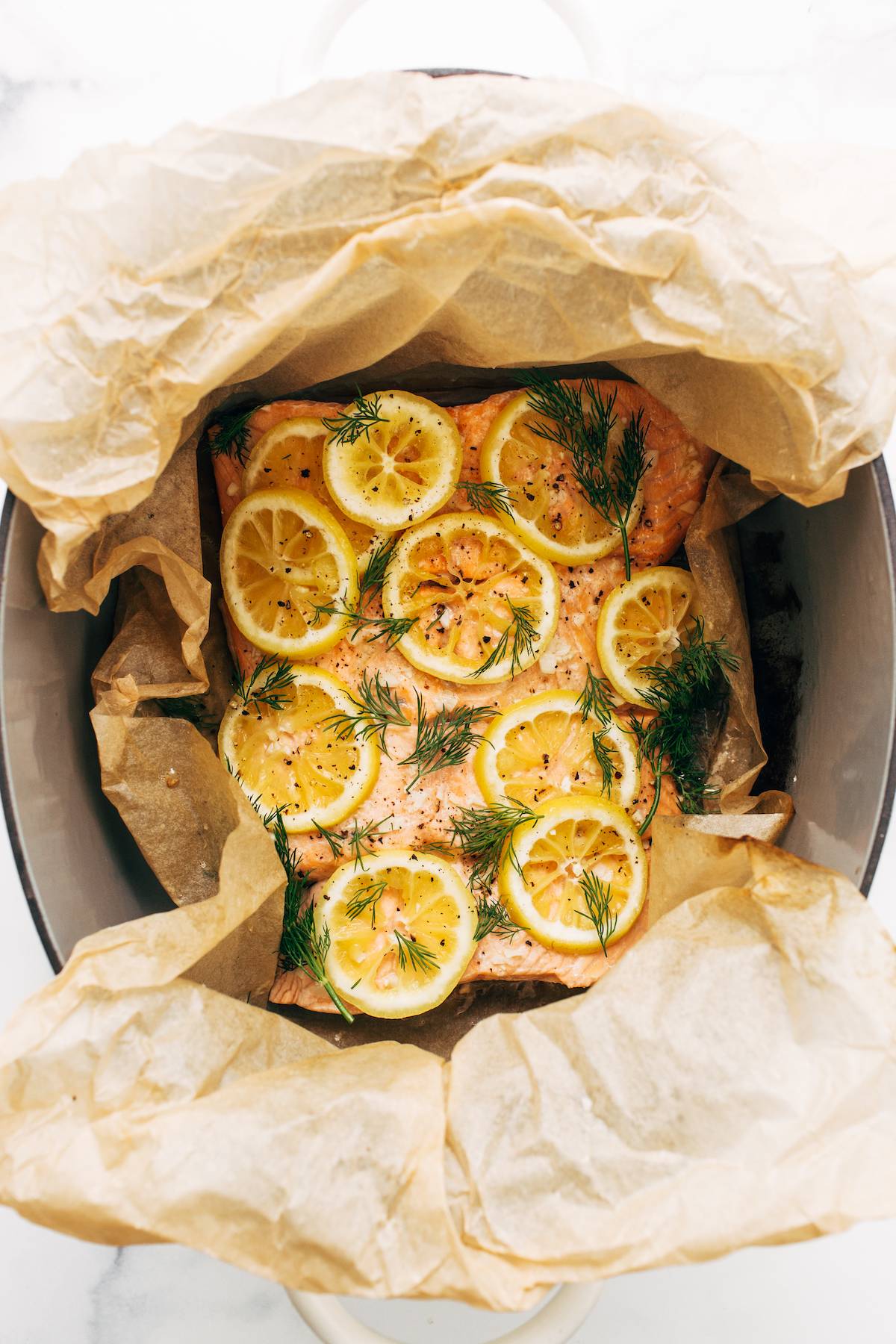
When to Steam Salmon
Steaming salmon is the way to go if you like tender, moist, fancy-but-not-hard-to-make salmon. In this method, the salmon is steamed in white wine with lots of fresh herbs and lemon. You could pair it with a sauce but really, the salmon is all you really need.
Directions
- Cut an extra-large piece of parchment paper (about two-feet long) that’s big enough to fit your salmon fillets.
- Place the parchment paper in the bottom of a dutch oven*.
- Toss your salmon fillets in a separate bowl with some olive oil and any seasonings you’d like (salt, pepper, fresh garlic, sliced onion or shallots).
- Place the seasoned and oiled salmon in the parchment-lined dutch oven. Add some lemon slices if you wanna be fancy Add about 1/3 cup of water, white wine, or broth on top. Fold the parchment over the fish and crimp/fold it together to seal it up.
- Cover the pan with a lid and let it cook on high heat on the stovetop for 5 minutes. After 5 minutes, reduce the heat to medium and cook for another 8-10 minutes. Remove from heat and let it rest for a few minutes to finish.
- Remove the lid, open the parchment, and top with your favorite fresh herbs!
Watch How to Steam Salmon
This method was inspired by the delicious and amazing Steamed Salmon with Garlic, Herbs, and Lemon from What’s Gaby Cooking which is a recent team favorite!
How To Sauté Salmon
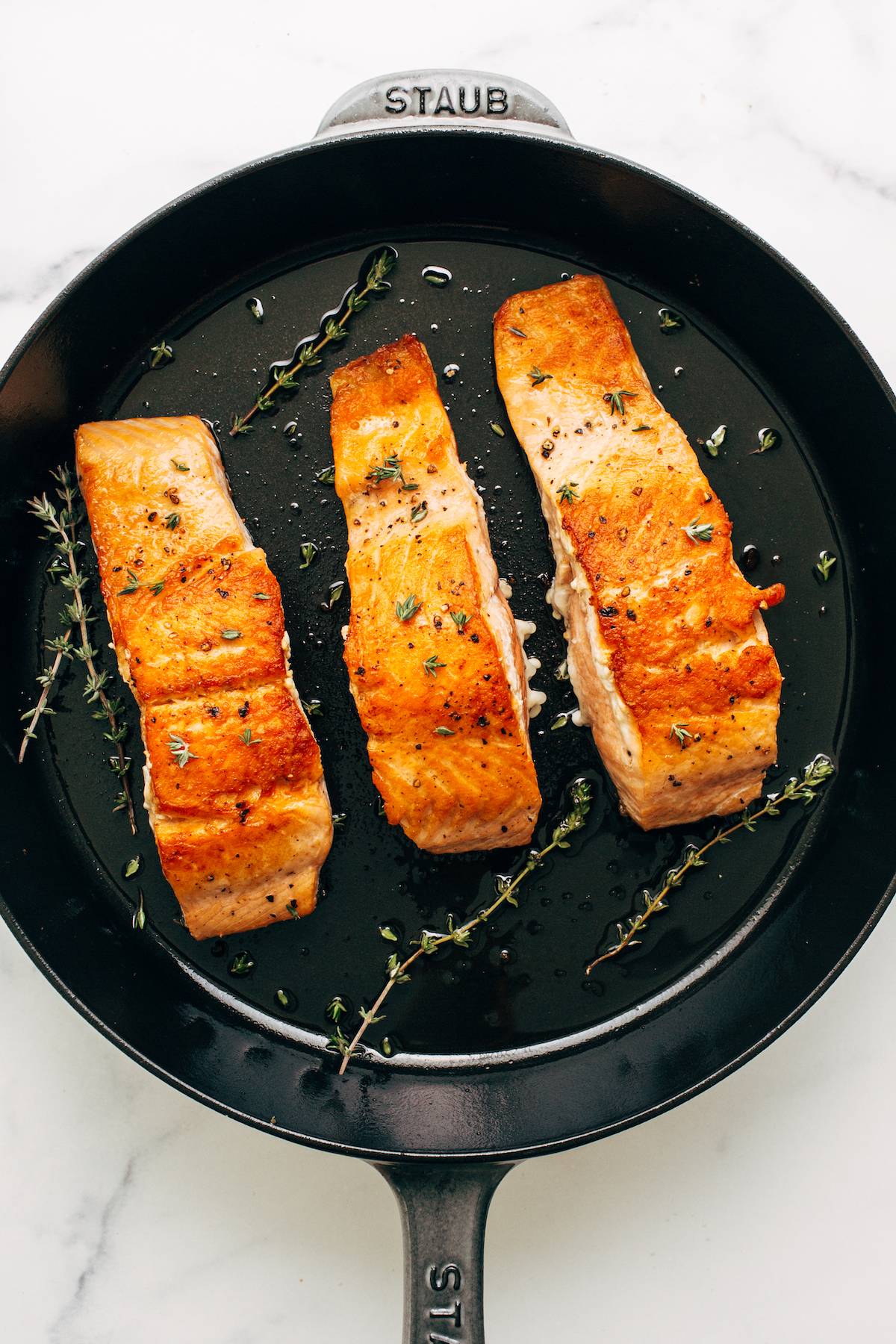
When to Sauté Salmon
We love to go the sauté route when we want a crispy top to hold up to a delicious pan sauce. Or, if we want to keep a litttttttle closer eye on things than just popping it in the oven. You have full control over the crispiness, the temperature, the flavor, everything.
Directions
- Allow salmon to come to room temperature for 15-25 minutes before sautéing the fish. Season salmon fillets to your liking.
- Heat a nonstick skillet or cast iron skillet* over medium heat with a couple tablespoons of oil.
- Pat fish dry to remove extra moisture before adding it to the pan. Add salmon to the pan with the skin side facing down. Leave the salmon undisturbed in the pan.
- Once the salmon starts to turn a bit opaque in color and looks a bit more “done” (this should be about 6 minutes or so, depending on salmon fillet thickness), flip your salmon and cook it for another 2 minutes in the pan to get the top layer crisped. At this time and temp, your salmon should be considered medium-rare to medium doneness.
Watch How to Sauté Salmon
Recipes Using Sautéed Salmon
How To Air-Fry Salmon
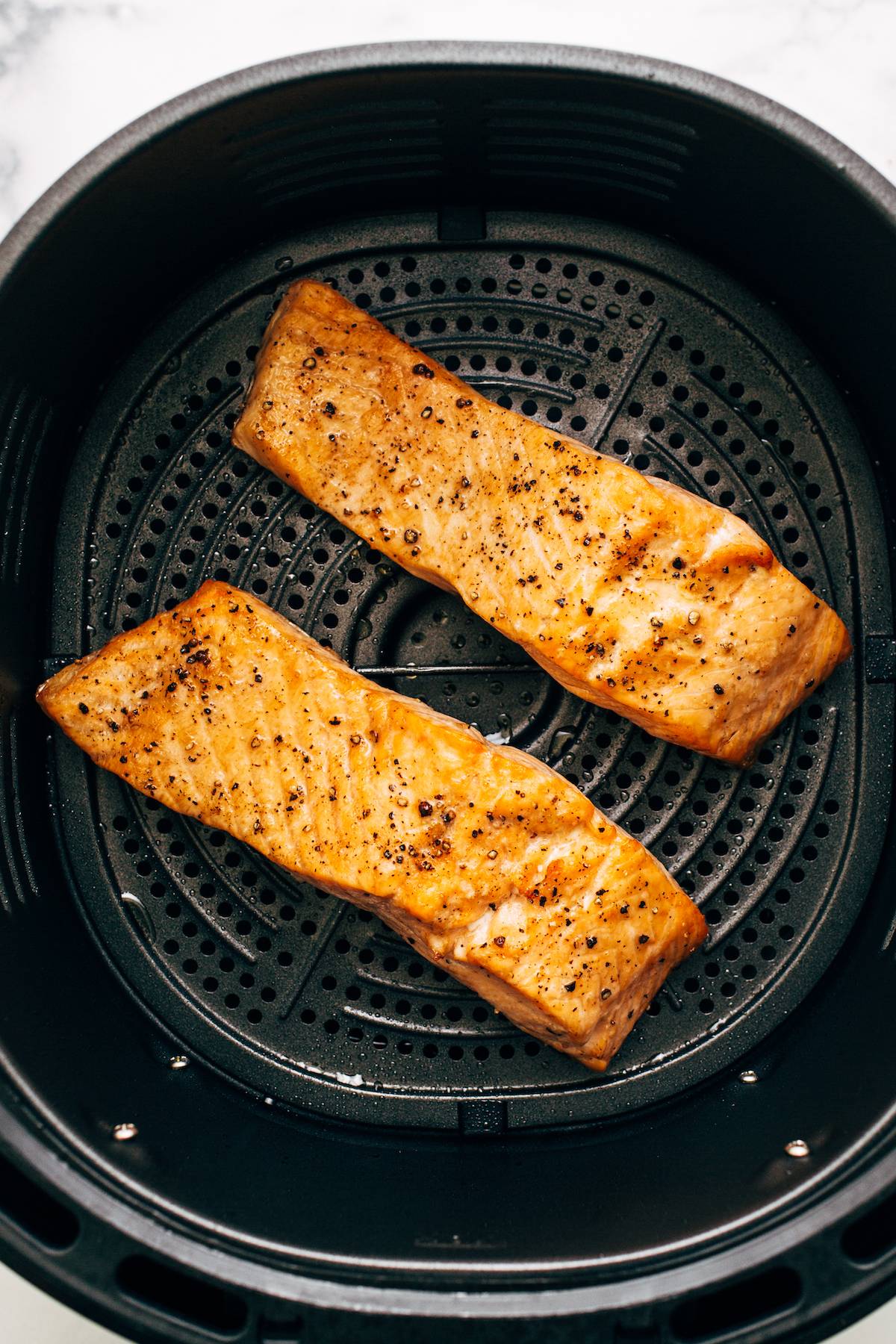
When to Air Fry Salmon
This one’s for you if you’re a set it and forget it kinda salmon-lover who wants to make things weeknight-easy. And THOSE CRISPY EDGES. Perfection.
Directions
- Preheat your air fryer* to 400 degrees F. Coat salmon lightly with olive oil and season the fillets to your liking.
- Spray your air fryer basket with non-stick cooking spray. Air fry salmon for 7-9 minutes.
- When the salmon is cooked to medium or medium-rare, it should be opaque. If it still looks “raw” or uncooked, return it to the air fryer for another minute or two. You may need to do this if you have a thick salmon fillet.
BONUS: How To Make Salmon Burgers
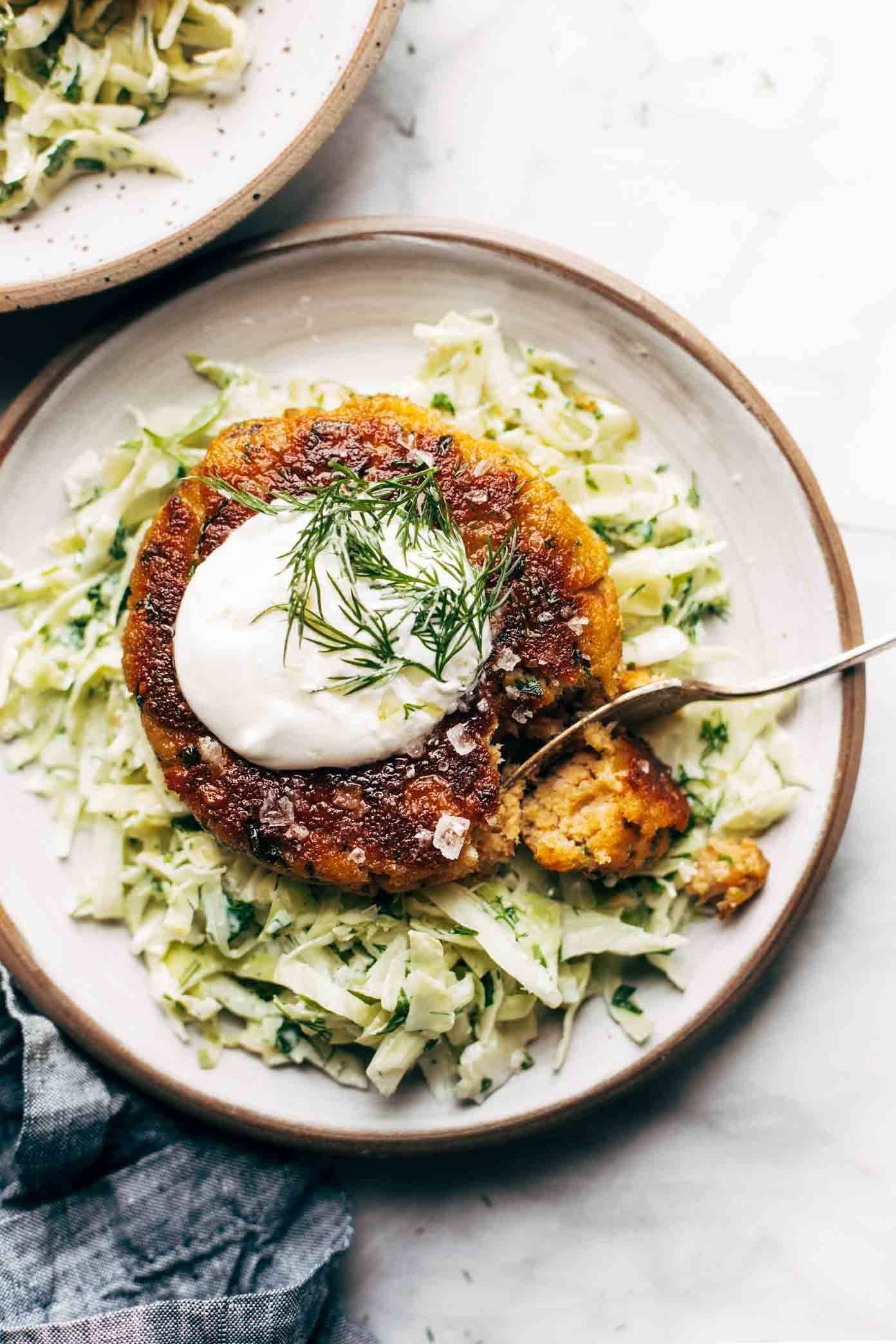
Directions
- Bake salmon according to one of the “How to Bake Salmon” methods above or use canned salmon*.
- Using about 12 ounces of salmon, flake the salmon apart and combine the fish with 2 eggs and 1/2 cup of breadcrumbs. Season the salmon burgers with your seasonings of choice. Form into patties.
- Heat oil in a nonstick skillet with a few tablespoons of oil.
- Fry salmon burgers for 2-3 minutes on each side until they’re crispy.
Tips On Buying Salmon
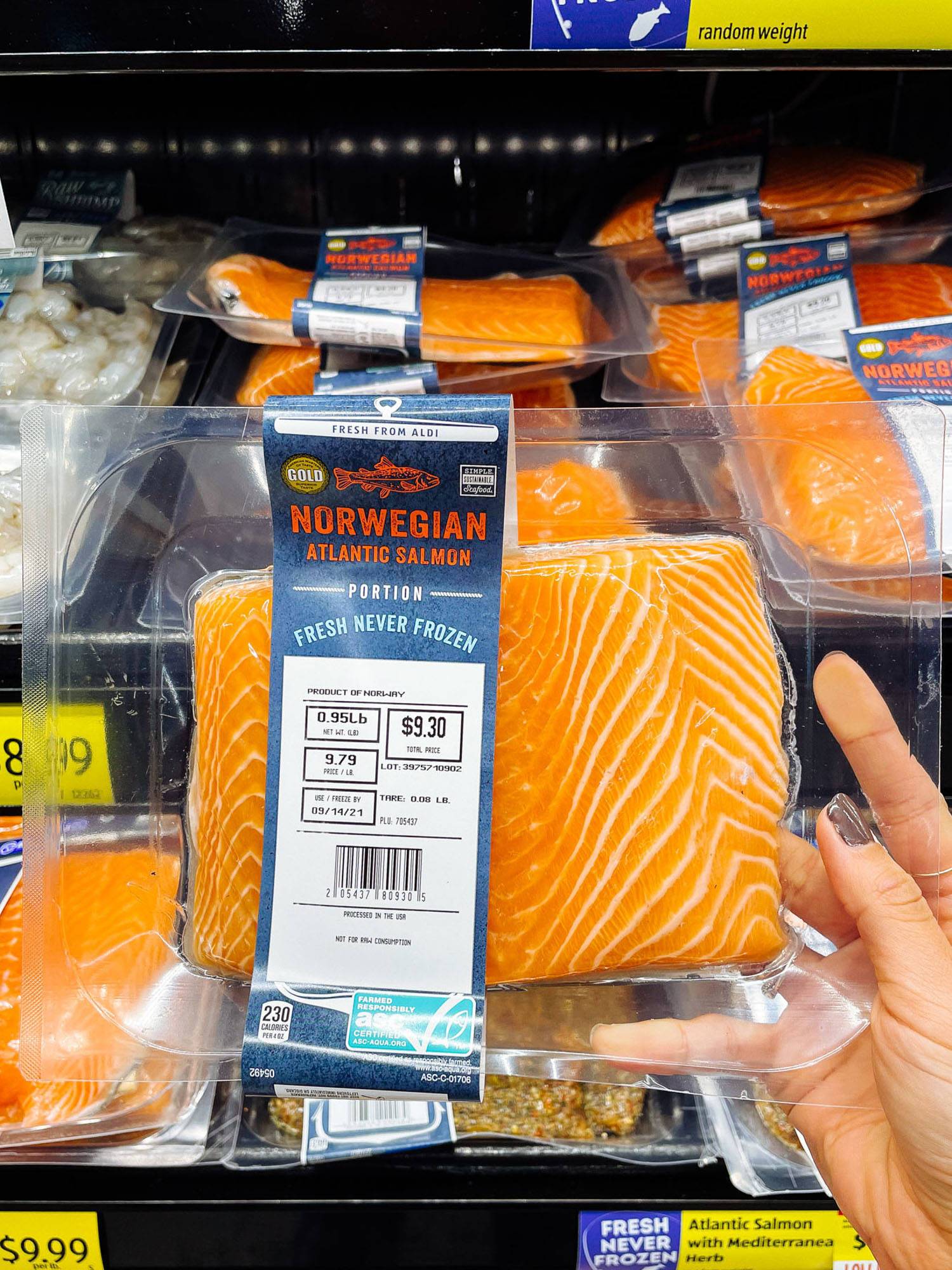
Types of Salmon
The brightness of the salmon pink will vary depending on the variety you’re buying. Here are a few common varieties below:
- Atlantic Salmon: This is a common grocery store variety to stumble upon and a delicious one, at that. This variety is mild, buttery, and has a medium-firm texture.
- Coho Salmon: A great starter salmon variety! The flavor is fairly mild compared to other varieties.
- King Salmon: The creme de la creme of the salmon world. It lends a beautiful buttery taste, but it’s also the most expensive type of salmon.
- Sockeye Salmon: This variety is a really vibrant orange / deep red color. It has a really rich, deep flavor, but note that it’s a bit drier than other varieties.
If we had to pick a favorite out of all the options, Atlantic Salmon is our go-to!
Fresh vs. Frozen Salmon Tips
So you’ve chosen your salmon and guess what! Now you have to choose between fresh or frozen! Both are just as good as the other, and it just depends on how and when you’re cooking it. Ifvyou’ll be cooking it the following day or two, fresh salmon is great. But if you won’t be enjoying it until the end of the week, opt for frozen (and bonus: you can buy the BIG bags of frozen salmon to stock up for more meals at your leisure!).
A few other tips:
- Fresh salmon should have a very mild fish smell. Avoid buying overly fishy-smelling fish.
- Avoid fresh salmon that has any brown spots on the flesh.
- For both fresh or frozen salmon, try to choose salmon fillets or steaks that are all about the same thickness so that all the fillets can cook consistently.
- Frozen salmon can sometimes be more affordable than fresh salmon. Just thaw the salmon before preparing it and pat it dry to remove extra moisture.
How to Thaw Frozen Salmon
The best and safest way to thaw frozen salmon is to put your fillets or steaks in a large bowl of cold water and place your vacuum-sealed salmon in the bowl. Toss the bowl in the fridge for a few hours until your salmon is fully thawed.
Salmon Doneness
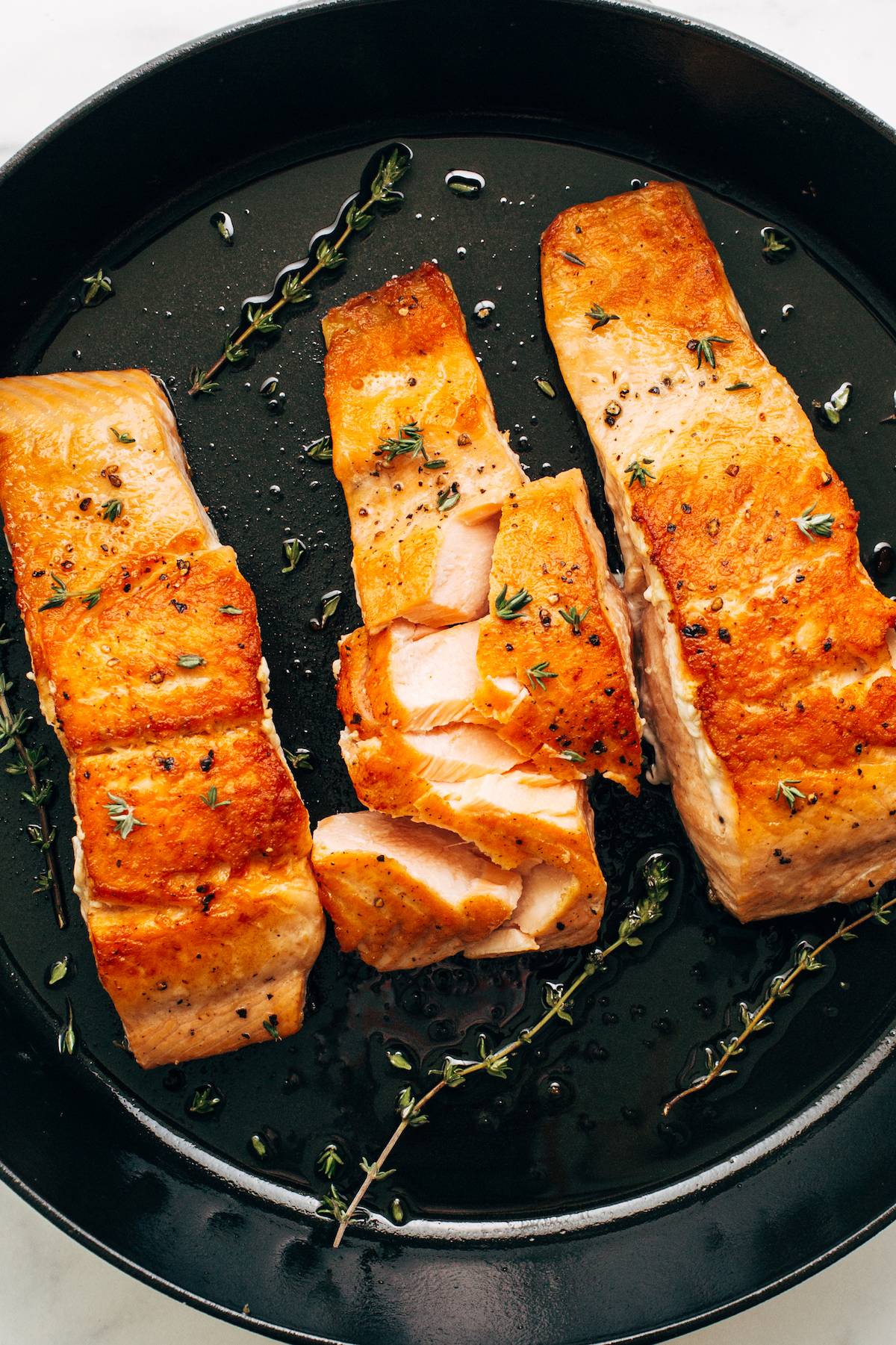
The best way to determine salmon doneness is with a food thermometer*. Just insert the probe into the thickest part of the salmon fillet or steak. If you don’t have a food thermometer though, you can get a pretty good idea of how done your fish is if it’s starting to flake apart when you poke at it with a fork.
- For rare salmon: Cook to less than 125 degrees F.
- For medium-rare salmon: Cook to 125-130 degrees F.
- For medium salmon: Cook to 130 to 140 degrees F.
- For well-done salmon: Cook to 140 degrees F or higher. (Note that cooking to this temp will make your salmon pretty dry, and in our opinion it’s not the best way to enjoy salmon.)
Eating Raw Salmon
Salmon can definitely be eaten raw, especially if you are preparing it as part of sushi. The key to enjoying salmon raw is buying as fresh of fish as you can find – sometimes going to a specific fish market is best for this. Look for fish that’s labeled “sushi grade” or “sashimi grade”. It’s best to prepare your raw fish within 1-2 days after purchasing it for optimal freshness.
How To Remove The Skin On Salmon
If you prefer to enjoy salmon without picking around the skin, there are a couple different ways to remove it. But if you want to enjoy your salmon with the skin on and eat that crispy delicious skin, here’s more info on that.
- If you’re buying fresh salmon, ask a grocery store employee behind the fish / seafood counter if they can remove the skin for you (this is the easiest method).
- Remove the skin yourself by gripping your salmon fillet tautly and making a cut using a sawing motion between the skin and the fish flesh. Note that the fish will be slippery, so please be careful!
Based on what method you’re using, here’s when it’s best to remove the skin if you so choose:
- If you’re baking salmon: remove the skin before baking.
- If you’re steaming salmon: remove the skin before steaming.
- If you’re air-frying salmon: remove the skin after air frying.
- If you’re sautéing salmon: keep the skin on while cooking and when the fish is almost done cooking and the fillet is skin side up.
So Much Nutritional Goodness In Salmon
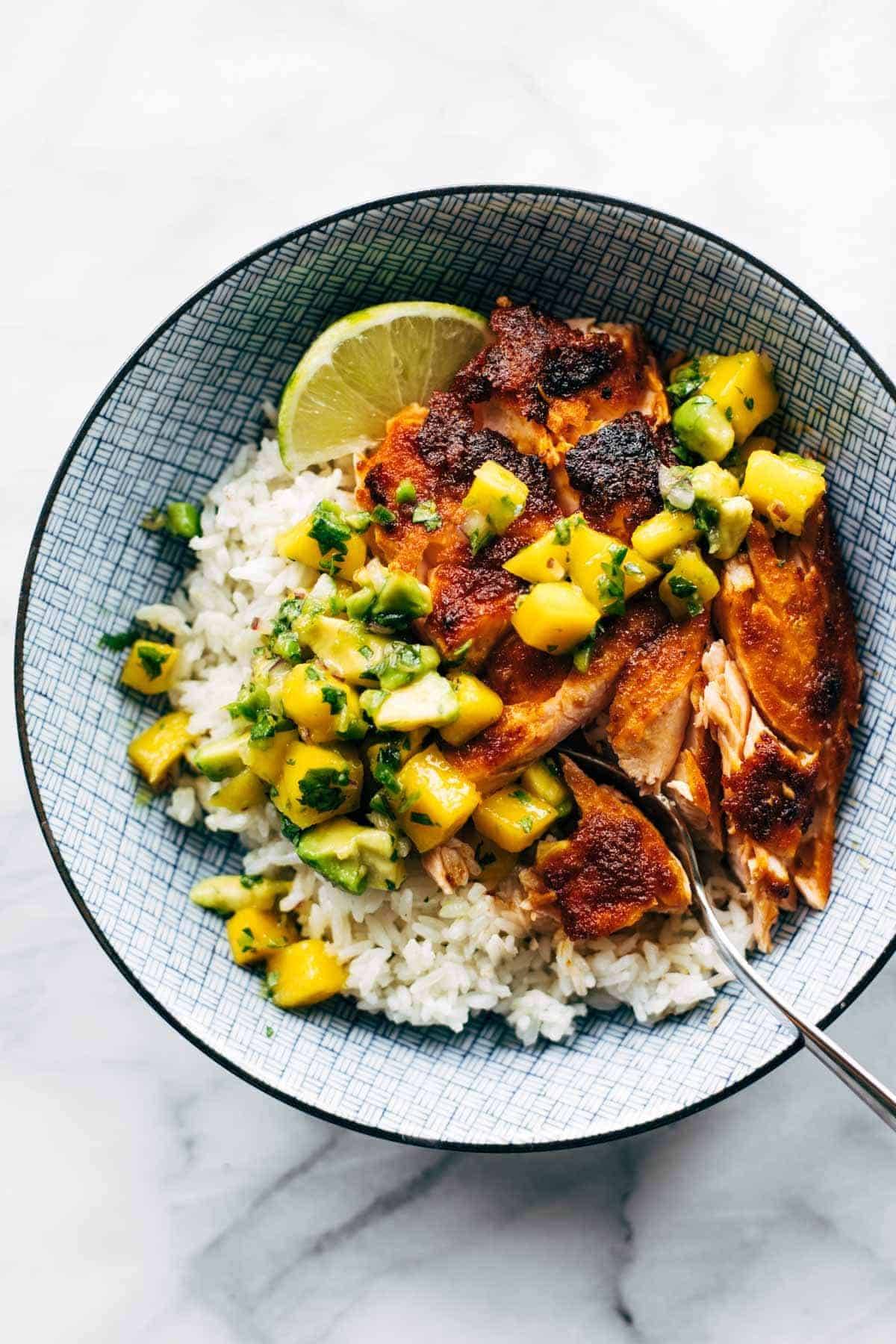
There’s so much to love about salmon, but one thing we love in particular is how wholesome it is for you. It’s like giving your body a big nutritional hug each time you eat it. 🤗
- It’s high in omega-3 fatty acids (these fatty acids help to reduce inflammation in the body).
- It’s a great source of protein (yay for strong muscles!).
- It helps support brain function (always gotta keep that noggin’ joggin’).
- It’s packed with lots of different body-supporting vitamins (like potassium, selenium, and a variety of B vitamins).
Our Most Popular Salmon Recipes
WE LOVE SALMON! Here are our all-time favorite salmon recipes.
- Baked Salmon with Amazing Lemon Sauce
- Coconut Curry Salmon
- Yummy Salmon Burgers with Slaw
- BBQ Salmon Bowls with Mango Avocado Salsa
- Spring Salmon with Creamed Leeks, Potatoes, and Asparagus
- The Oliver’s Salad
- Spicy Salmon Burgers
- Hot Honey Salmon
Products We Love That Make Cooking Salmon a Breeze


